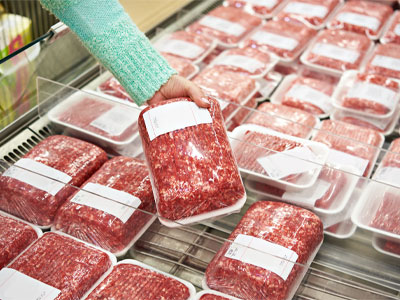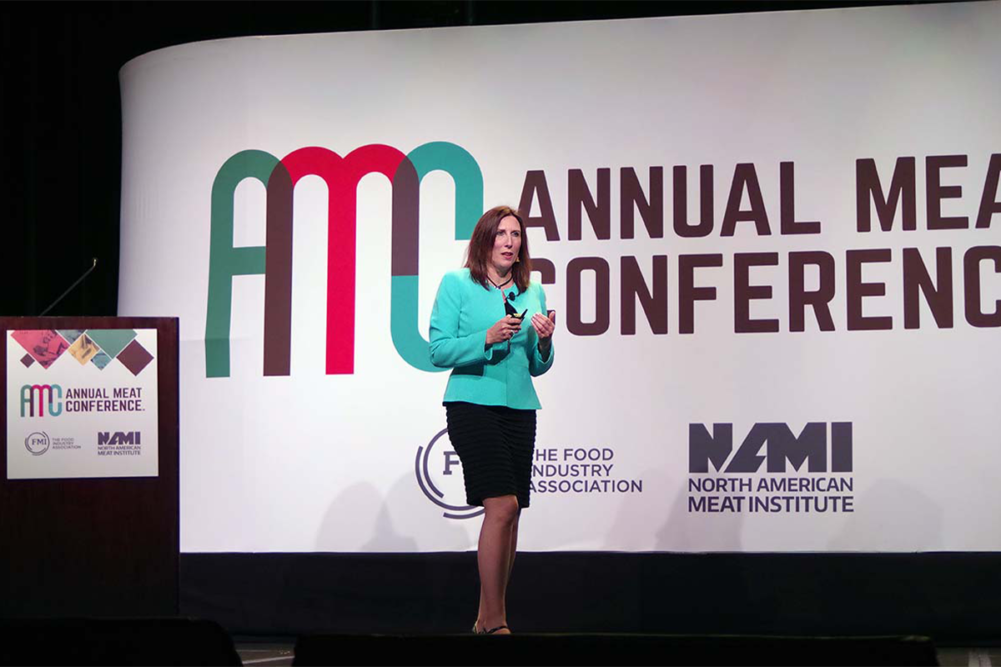DALLAS — Consumers are buying more fresh meat and poultry than before the pandemic, but shoppers’ purchasing decisions are driven by a laser-like focus on value in terms of price, convenience and other attributes, according to the Power of Meat report published by the North American Meat Institute and FMI – The Food Industry Association and sponsored by Sealed Air’s Cryovac. Anne-Marie Roerink, principal, 210 Analytics, presented the 18th edition of the report — which includes data and insights from IRI (now called Circana) — during the 2023 Meat Conference in Dallas March 5-8.
“We all know that in ’22, the headlines were all taken by inflation — not just in our category but in grocery shopping and life altogether,” Ms. Roerink said. “All-in-all, the meat department had an increase of prices of 8.5% that was actually less than that of total food and beverages.”
Meat remained the most dominant supermarket perimeter department with $87.1 billion in annual sales, 98.3% household penetration and nearly 50 shopping trips per year, the report said. Sales reached another record, up 5.7% versus a year ago, and retailers continued to move more pounds than before the pandemic.
The leading drivers of meat purchase decisions were product quality and appearance followed by price per pound and total package price. Beef is the biggest seller in fresh, followed by chicken. In processed meats, bacon and pre-packaged lunch meat were top sellers.
“On the processed side, sales reached $29 billion,” Ms. Roerink said. “We saw a little bit more inflation in that area, and that really resulted in a little bit more volume pressure as well. Bacon always was the big seller, and we’re now out-done by packaged lunch meat that had very high inflation, but at the same time, continued demand with just a little bit of volume pressure.
“There, too, it was really a lot of innovation that kept a lot of feet going down those processed meat aisles as well. We saw innovation in flavors with things like ranch bacon and taste like chicken Parmesan sausage. We saw signature items popping up in the full-service case and the self-service case.”
 Meat remained the most dominant supermarket perimeter department with $87.1 billion in annual sales, 98.3% household penetration and nearly 50 shopping trips per year. Photo: ©SERGEY RYZHOV – STOCK.ADOBE.COM
Meat remained the most dominant supermarket perimeter department with $87.1 billion in annual sales, 98.3% household penetration and nearly 50 shopping trips per year. Photo: ©SERGEY RYZHOV – STOCK.ADOBE.COMDespite rising prices across stores, the volume of meat consumers bought in 2022 did not significantly change, down 2.5% compared to 2021, although consumers surveyed for the Power of Meat reported utilizing cost-saving strategies to stretch their dollars.
“To save money, a large majority of consumers (76%) report they made changes to the amount, type, cut, and/or brand of meat they purchase or changed where they shop,” the report said. “Consumers’ top strategies to save money include buying only the amount needed (42%), looking for coupons (35%) and stocking up when meat is on sale (35%).
“Seventeen percent said they buy less meat with organic, grass-fed or other claims. Only 16% of meat shoppers said they cook more meatless meals to save money. Of the 33% of Americans who said they are looking to eat less meat or chicken, 52% cite cost as the reason (up from 16% in 2020).”
When people decide where to shop in these inflationary times, price considerations rise to the top of consumers’ minds, Ms. Roerink said.
“The very first time we did this study in 2006, 95% of people shopped at a primary store — so a store where they spend the majority of their dollars — that is down to 76%,” she said. “So, it means the dollar is more widely distributed now than it was 18 years ago.”
Shifts in channel choices are driving changes in the meat and poultry dollar distribution, according to the report. Data from Circana showed demographic and inflationary forces resulted in a loss of share for traditional grocery from 42.8% of meat and poultry sales in 2019 to 40.3% in 2022, representing a shift of several billions of dollars.
“Supercenters, clubs and online outlets, all over indexing for millennials, gained in share,” the report said. “Online meat sales grew on better conversion and more frequent orders.”
Another money-saving tactic shoppers reported was cooking at home returning to 2018 levels. Americans prepare between four and five dinners at home during a typical week, 87% of which (four per week) contain a portion of meat or poultry, according to the Power of Meat report.
Popularity of value-added meat and poultry products has skyrocketed. Purchases of pre-marinated, pre-cut or pre-seasoned meat have increased dramatically, with 73% of shoppers saying they “sometimes or frequently bought these products in 2022, up from 60% in 2020,” according to the report. And 55% of Americans reported using some or mostly semi- or fully- prepared foods in their dinner preparation compared to 45% who cook mostly from scratch.
“The research tells us that we’re seeing a more price-conscious shopper, but we’re also witnessing shoppers seeking ‘simple pleasures’ and that’s one area among others where the meat department can delight,” said Rick Stein, vice president of fresh foods for FMI. “For example, shoppers concerned about food prices might opt to splurge on an at-home date-night meal. Food retailers can best serve today’s shoppers by emphasizing value-added meat options and catering to shoppers with meal solutions.”





